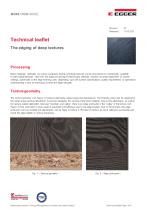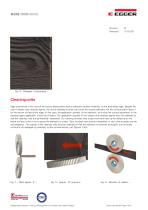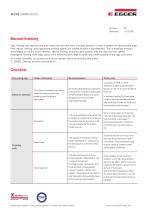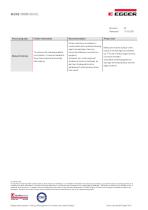
Catalog excerpts

Revision: Released: Technical leaflet The edging of deep textures Processing Board materials, laminates as w ell as composite boards w ith deep textures can be processed on commercially available w oodw orking machines. How ever, the edge processing of these board materials requires accurate adjustment of system settings, specifically on the edge finishing units. Depending upon the system specifications, quality requirements or operational understanding it may be necessary to finish the edge manually. Texture geometry The texture geometry (ref. Figure 1) features alternating raised areas and depressions. The finishing units must be adjusted to the raised areas (texture elevations) to prevent damaging the surface of the board material. Due to this adjustment, as w ell as the texture-related alternation betw een "mountain and valley", there is an edge protrusion in the “valley” of the texture (ref. Figure 2) This protrusion in most cases is saturated w ith adhesive due to the edge location. Due to the process, this edge protrusion can’t be avoided but adjustments can be made to reduce it. Proceed to remove as much adhesive as possible and round the edge slightly to reduce sharpness. Responsible person: Product Management Furniture and Interior Design Technical leaflet
Open the catalog to page 1
Adhesive The amount of adhesive applied should be the minimum required needed in effort to reduce excess and rapid dispersion. The use of colored adhesives is recommended and proven to be a useful visual tool. Also, the use of release agents and coolants is highly recommended. Any adhesive residue remaining on the board surface after edging should be removed promptly. Adhesive residue remaining on components for too long can lead to irremovable soiling of the components. Depending on the type of adhesive used blocking can occur within a stacked tower and eventually causing irreparable...
Open the catalog to page 2
Revision: Released: Scanning Scanning rollers In most cases, the upper scanning of the w ork pieces is done by means of scanning rollers as they have proven their w orth over the years. The diameter of the scanning rollers varies from 70 to 225 mm, and ranges from single scanning rollers to triple scanning rollers. The diameter of a scanning roller is vital for good milling results w ith deep textures. A large scanning roller diameter provides w ider "scanning roller support" and therefore leads to a better milling result. Smaller diameters of the scanning rollers inevitably result in...
Open the catalog to page 3
Revision: Released: Fig. 6 – Damaged surface layer – Cleaning units Edge protrusions in the area of the texture depressions lead to adhesive residue remaining on the protruding edge. Despite the use of release and cleaning agents, the use of cleaning brushes can brush the excess adhesive into the surface and/or leave it on the narrow surface of the edge. In this case, the application quantity of the adhesive, as w ell as the correct adjustment of the cleaning agent application should be checked. The application quantity of the release and cleaning agents must be selected so that the...
Open the catalog to page 4
Manual finishing Edge finishing and cleaning units often reach their technical limits with deep textures. In order to achieve the best possible edge finish manual finishing using appropriate cleaning agents and suitable brushes is recommended. This is especially effective when edging across the texture direction. Manual finishing should be done promptly after the edge has been applied. Subsequent finishing of the edge radius with a hardwood block helps to soften and smooth possible sharp edge protrusions. For further information on cleaning our surfaces, please refer to the technical data...
Open the catalog to page 5
Revision: 00Released: 17.03.2021 Processing step Provisional note: This technical leaflet has been carefully drawn up to the best of our knowledge. It is intended for information only and does not constitute a guarantee in terms of product properties or its suitability for specific applications. It is based on practical experiences, our own tests and correspond to our present state of knowledge. W accept no liability for any mistakes, errors in standards, or printing errors. In addition, technical modifications may result from the continuous development of EGGER Edging, as well as from...
Open the catalog to page 6All EGGER catalogs and technical brochures
-
Company Brochure
80 Pages
-
EGGER PRO Flooring Collection 2021+
229 Pages
-
Egger Accessory System
12 Pages
-
Egger HOME Flooring
44 Pages
-
MORE FROM WOOD.
2 Pages
-
Make responsible product choices
10 Pages
-
Eurolight® Lightweight Boards
40 Pages
-
Products, decors and services
40 Pages
-
EGGER OS´Brace™
1 Pages
-
EGGER OS´Brace™ – H2 Blue
1 Pages
-
ABS EDGING
4 Pages
-
Passion for a unique resource.
82 Pages
















